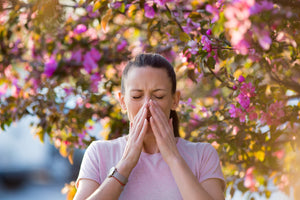Feeling like your seasonal allergies are worse this year? You’re not alone and there is data to explain why.
Toronto has been hit with more than double the amount of pollen (7,790 grains per cubic metre) in May 2021 compared to the same period last year. Montreal’s pollen levels have skyrocketed to 10,407 from 4,919 from last year.1
Daniel Coates, the director of Aerobiology Research Laboratories has even stated “For the most part, in Canada, in many regions, we’ve seen higher than your typical average pollen counts.”
One way to help relieve pollen allergy symptoms and hayfever is to invest in a HEPA air purifier. At UV Can, our top-selling Tulip 2 and Cosmos Wall Mount air purifiers are not only equipped with a HEPA filter and activated carbon filter for allergens, but also germicidal UV-C lights that disinfect the air from viruses and bacteria.
Tulip 2 UV Air Purifier |
Cosmos Wall Mount Air Purifier |
 |
 |
| Tulip 2 is the best portable air purifier for your home or your desk in the office as it disinfects and purifiers the air at a rate of 2,472 to 3,885 ft³ per hour. | Cosmos Wall Mount disinfects at a rate of 35,300 ft³ per hour making it perfect for your large office space, boardroom, or reception area. |
Wondering which plants are to blame for your runny nose and itchy eyes? We’ve prepared an allergy season guide of some of the most common weeds, grasses, and trees across Canada:
1. Ragweed
Where: Alberta, British Columbia, Manitoba, New Brunswick, Newfoundland & Labrador, Nova Scotia, Northwest Territories, Ontario, PEI, Quebec, Saskatchewan
When: June to August
This invasive plant unleashes tremendous amounts of pollen and is the bane of existence for allergy sufferers. Its flowers are very inconspicuous, so it relies on the wind rather than insects to spread pollen.2
2. Blue Grass
Where: Alberta, British Columbia, Manitoba, New Brunswick, Newfoundland & Labrador, Nova Scotia, Northwest Territories, Ontario, PEI, Quebec, Saskatchewan, Yukon
When: May to August
Blue grass is usually used for animal food or lawns. It releases grass pollen when it starts to flower, so make sure to cut your lawn frequently to reduce grass pollen shed.3
3. Ryegrass
Where: Alberta, British Columbia, Manitoba, Ontario, Quebec, Saskatchewan
When: March to June
Wildlife uses ryegrass for their nesting material, and birds and rodents eat the seeds. This grass can grow 2 to 4 ft tall, and the stems droop from bristly seed heads that appear in the fall.4
4. Bermuda Blue-Eyed Grass
Where: British Columbia, Nova Scotia, PEI, Quebec
When: March to July
These grasses have narrow, light-green leaves and grow in dense, tufted clumps. They can grow light-blue, star-shaped flowers and they are actually part of the Iris family.5
5. Mold Spores
Where: Alberta, British Columbia, Manitoba, New Brunswick, Newfoundland & Labrador, Nova Scotia, Northwest Territories, Nunavut, Ontario, PEI, Quebec, Saskatchewan, Yukon
When: June to November outdoors, year-round indoors
Mold and mildew are fungi, and they use spores instead of seeds to reproduce. Breathing in indoor and outdoor mold spores can cause allergy or hay fever symptoms.6
6. Bur Oak
Where: Alberta, Manitoba, New Brunswick, Ontario, Quebec, Saskatchewan
When: March to May
These trees are wide and tall, with the ability to exceed 100 feet in height and width. Bur Oaks are popular in urban environments as they are resistant to air pollution and car exhaust.7
7. White Birch
Where: Alberta, British Columbia, Manitoba, New Brunswick, Newfoundland & Labrador, Nova Scotia, Northwest Territories, Ontario, PEI, Quebec, Saskatchewan, Yukon
When: April
Birches are known for their white bark and how their bright green leaves change to yellow in the fall. While they’re very beautiful, just one birch tree in spring can produce up to 5 million pollen grains that travel up to one kilometer. Birch pollen allergy is very common in Canada.8 9
8. Pine
Where: Alberta, British Columbia
When: April
Pine trees are very tall and have soft, blue-green needles in groups of five. Pine tree pollen levels are highest in the morning while the air is dry, so it is better to postpone outdoor activities or hanging wet laundry until the afternoon.10 11
9. Maple
Where: New Brunswick, Nova Scotia, Ontario, PEI, Quebec
When: April
These are Canada’s national tree, known for their brilliant fall colours, popular furniture wood, and of course, maple syrup. Each tree yields 20 to 230L of sap per year; it takes 120L of sap to make 4L of maple syrup or 2kg of sugar.12
10. Eastern Cottonwood
Where: Alberta, British Columbia, Manitoba, Ontario, Quebec, Saskatchewan
When: February to April
Cottonwoods are one of the fastest growing native trees in North America. They got their common name from how they produce clouds of cottony seeds each spring.13
If you're suffering from a pollen allergy in Canada, it's most likely caused by trees in Spring, grasses or weeds in Summer, or mold if it is year-round. We get that seasonal allergies add an extra layer of stress to daily life and they do nothing to help your mood or ability to focus.
Air purification is a great solution and investment for your indoor space. Be sure to check out the Tulip 2 UV air purifier for your home or office desk or the Cosmos Wall Mount UV air purifier for your large office space.
References:
- https://globalnews.ca/news/7908550/pollen-allergies-canada-2021/
- https://www.wildflower.org/plants/result.php?id_plant=AMAR2
- https://www.pollenlibrary.com/Genus/Poa/
- https://www.wildflower.org/plants/result.php?id_plant=ELCA4
- https://www.wildflower.org/plants/result.php?id_plant=SIAN3
- https://www.aafa.org/mold-allergy/
- https://www.wildflower.org/plants/result.php?id_plant=QUMA2
- https://www.wildflower.org/plants/result.php?id_plant=BEPA
- https://www.healthline.com/health/allergies/pollen#types
- https://www.wildflower.org/plants/result.php?id_plant=PIMO3
- https://acaai.org/allergies/types-allergies/pine-tree-allergy
- https://www.wildflower.org/plants/result.php?id_plant=ACSA3
- https://www.wildflower.org/plants/result.php?id_plant=PODE3

